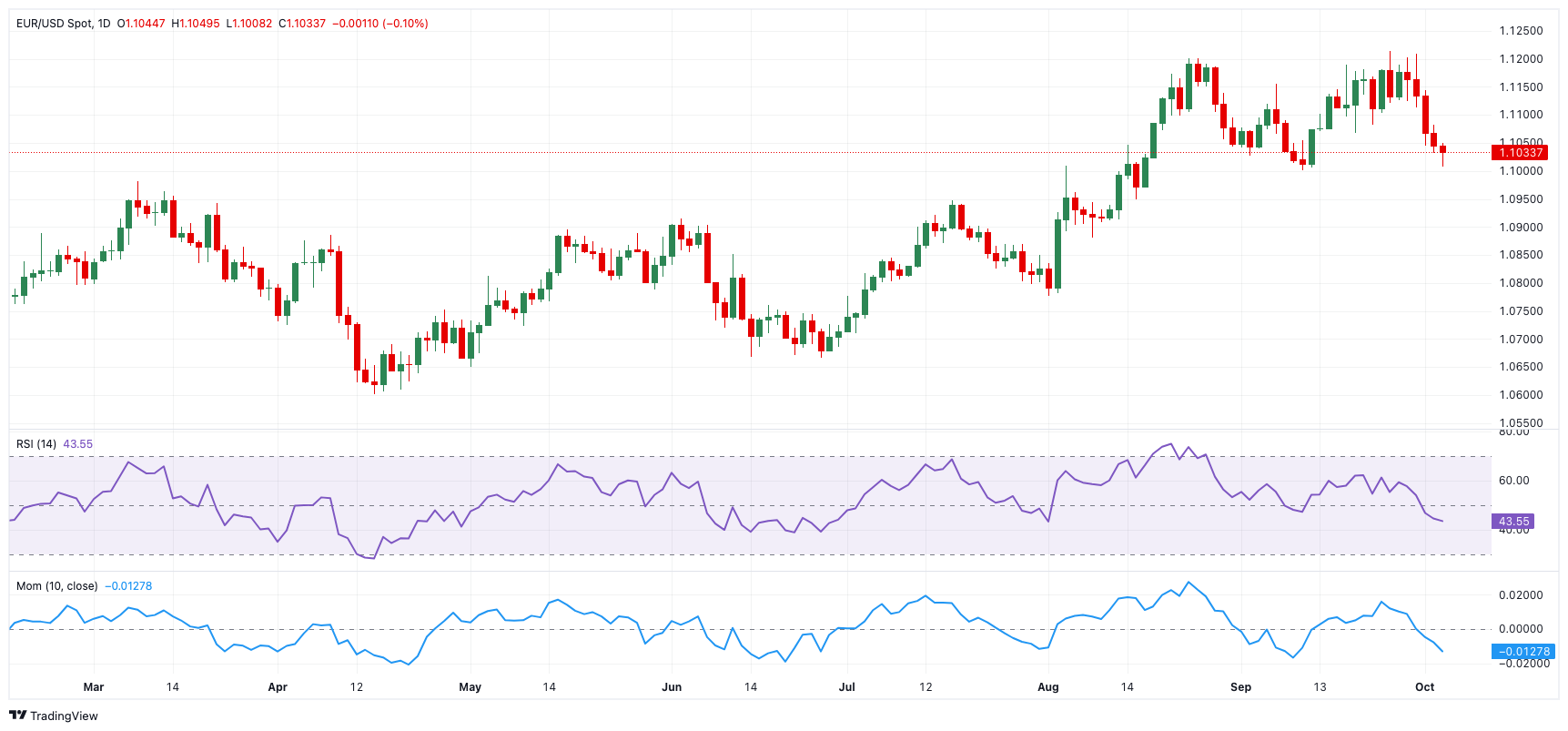- EUR/USD retreated to three-week lows near the 1.1000 zone.
- Further gains lifted the US Dollar to multi-week tops.
- The US ISM Services PMI rose well above consensus in September.
EUR/USD continued its uninterrupted decline on Thursday, hitting a three-week low just pips away from the key 1.1000 region due to ongoing risk aversion and further strengthening of the US Dollar (USD).
In fact, the Greenback advanced further as cautious sentiment prevailed amidst increasing geopolitical jitters in the Middle East, with concerns about potential retaliation by Israel still looming.
This persistent risk-off tone overshadowed investors’ optimism surrounding China’s recent stimulus measures, which aimed to stimulate its post-pandemic economy.
On the monetary policy front, bets for further easing by the Federal Reserve (Fed) in November and December remained steady, although the likelihood of another substantial rate cut appeared to be fading.
Recently, Chair Jerome Powell has signalled a preference for a 25-basis-point cut at those meetings, despite the market expecting around 75 basis points of easing by the year’s end.
In the same direction, Richmond Fed President Thomas Barkin mentioned that the Fed’s efforts to return inflation to its 2% target could take longer than expected, potentially limiting how much interest rates can be lowered.
Across the Atlantic, the European Central Bank (ECB) took a more dovish stance at its September meeting due to inflation and economic pressures. ECB President Christine Lagarde emphasized that domestic inflation remains elevated but noted that restrictive policies are starting to ease, which could support the economy. The ECB expects inflation to reach its 2% target by 2025.
Latest comments from Vice President Luis de Guindos hinted that Eurozone growth may be weaker than forecast in the short term, but he expressed optimism about a recovery led by rising real incomes and easing restrictive policies.
In addition, ECB board member Frank Elderson echoed expectations that inflation will reach the 2% target next year, but he cautioned against complacency given the structural changes facing the Eurozone. Similarly, ECB’s Isabel Schnabel suggested that inflation in the region is likely to return to the 2% target, fuelling expectations of future rate cuts.
Recent data showed that Eurozone inflation, as measured by the Harmonized Index of Consumer Prices (HICP), rose 1.8% in the year to September, while core HICP increased 2.7, all pointing to extra rate reductions as soon as this month.
Looking ahead, further Fed rate cuts could narrow the policy gap between the Fed and the ECB, potentially supporting EUR/USD. Markets expect two more rate cuts from the ECB and around 50 basis points of easing from the Fed for the remainder of the year. However, the relatively stronger performance of the US economy may prevent significant dollar weakness.
Speculative positioning shows that non-commercial net long positions in the Euro have reached a two-week high, while commercial players’ net short positions remain mostly unchanged. Despite ongoing volatility, EUR/USD has generally trended upward, hovering around the upper 1.1100 range.
EUR/USD daily chart
EUR/USD short-term technical outlook
Further declines could motivate EUR/USD to put the 1.1000 support to the test sooner rather than later. Once that region is cleared, spot could slip back to the weekly lows of 1.0949 (August 15) and 1.0881 (August 8).
On the upside, initial resistance is at the 2024 high of 1.1214 (September 25), followed by the 2023 top of 1.1275 (July 18) and the 1.1300 round level.
Meanwhile, the pair’s rising trend is expected to continue as long as it stays above the critical 200-day SMA of 1.0874.
The four-hour chart shows a deepening of the negative trend. The initial resistance level is at the 200-SMA at 1.1106 ahead of 1.1143 and then 1.1214. On the other side, the first support is 1.1007, closely followed by 1.1001 and then 1.0949. The relative strength index (RSI) dropped to about 34.




